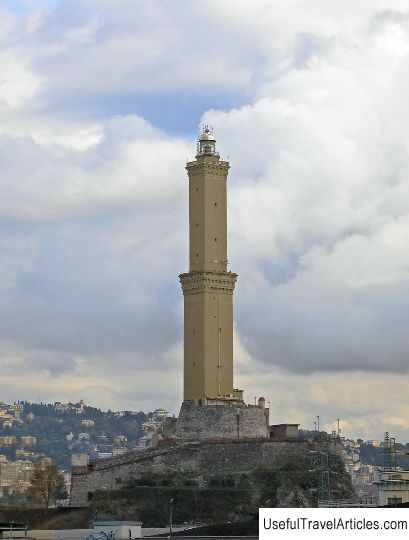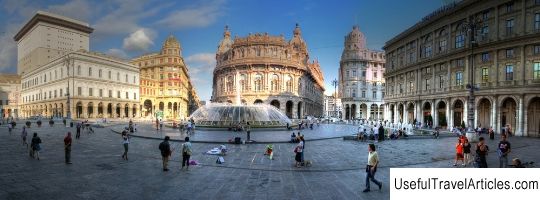Lighthouse Lanterna description and photos - Italy: Genoa
Rating: 7,8/10 (400 votes) 
Lanterna lighthouse description and photos - Italy: Genoa. Detailed information about the attraction. Description, photographs and a map showing the nearest significant objects. The name in English is Lanterna. Photo and descriptionLanterna lighthouse - one of the oldest in the world - is the main lighthouse of the Genoa port and one of the symbols of Genoa. In addition, it is the second tallest brick lighthouse in the world - its height reaches 76 meters. The lighthouse was erected on the hill of San Benigno, where the monastery of the same name once stood, not far from Sampierdarena - the port and industrial area of Genoa. It consists of two square parts, each of which ends with a small ledge, and a lantern is installed at the top. This place was once a peninsula until its coastline was built up and changed. Lanterna marked the entrance to the old harbor of Genoa, now known as Porto Antico. Over time, the entire promontory on which the lighthouse stands became known as Capo di Faro - Cape Lighthouse. And today almost nothing is left of the San Benigno hill - its land was used to expand the city's territory. According to most historical sources, the first lighthouse, which consisted of three crenellated towers, was built here around 1128. It was far enough from the city for that time, and only in the 17th century the lighthouse was territorially included in the so-called Cherkia Seichenska - an old part of Genoa. In those years, dried heather and juniper were used to kindle signal lights. The maintenance of the lighthouse was paid from the tax levied on ships that entered the port. For some time, Lanterna played an important role in the struggle for power on the Apennine Peninsula between the Guelphs and the Ghibellines - during one of the battles, the Ghibellines seriously damaged the lighthouse, trying to drive out the Guelphs who had settled inside. In 1326, the first lantern appeared on the lighthouse, the fire of which was kindled with olive oil so that ships passing by could better see its light. For the same reason, in 1340 the tower itself was painted with the coats of arms of the city, and it also began to serve as a non-luminous navigation sign. Around 1400, a prison was organized inside the lighthouse - among its captives were King James II of Cyprus and his wife. A little later, one of the lighthouse keepers placed a fish and a gold cross on its dome as a symbol of Christianity. At the beginning of the 16th century, Lanterna was seriously damaged during the war between Genoa and France and after reconstruction it took the form in which it has survived to this day. Construction of the new lighthouse lighting system began in 1778 to eliminate the consequences of its use for several centuries. Rotating Fresnel lenses were installed in 1840 and the restored and modernized lighthouse was inaugurated in 1841. The last major renovation work on Lantern took place in the middle of the 20th century after the end of World War II. Today, next to the lighthouse, there is a small Lanterna Museum, opened in 2006. Here you can get acquainted with the history of Genoa and its port, as well as see some unique archival documents and exhibits related to the history of maritime navigation. Parts of the Fresnel lenses are also displayed here, demonstrating how the lighthouse works. And at the base of the lighthouse itself you can see a marble tablet with the inscription "Jesus Christus rex venit in pace et Deus Homo factus est", which has been preserved since 1603.      We also recommend reading Rheinfall (Rheinfall) description and photos - Switzerland Topic: Lighthouse Lanterna description and photos - Italy: Genoa. |




